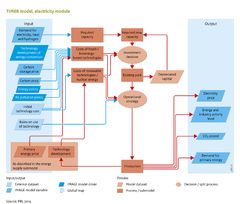Energy conversion/Description: Difference between revisions
Jump to navigation
Jump to search
No edit summary |
No edit summary |
||
| Line 20: | Line 20: | ||
==Fossil-fuel and bio-energy power plants== | ==Fossil-fuel and bio-energy power plants== | ||
A total of 20 different types of power plants, generating electricity using fossil fuels and bio-energy, are included. These power plants represent different combinations of (i) conventional technology; (ii) gasification and combined cycle (CC) technology; (iii) combined heat and power (CHP) and, (iv) carbon capture and storage (CCS) ([[Hendriks et al., 2004b]]). The specific capital costs and thermal efficiencies of these types of plants are determined by exogenous assumptions that describe the technological progress of typical components of these plants: | A total of 20 different types of power plants, generating electricity using fossil fuels and bio-energy, are included. These power plants represent different combinations of (i) conventional technology; (ii) gasification and combined cycle ([[HasAcronym::CC]]) technology; (iii) combined heat and power ([[HasAcronym::CHP]]) and, (iv) carbon capture and storage ([[HasAcronym::CCS]]) ([[Hendriks et al., 2004b]]). The specific capital costs and thermal efficiencies of these types of plants are determined by exogenous assumptions that describe the technological progress of typical components of these plants: | ||
*For conventional power plants, the coal-fired plant is defined in terms of overall efficiency and investment costs. The characteristics of all other conventional plants (using oil, natural gas or bio-energy) here are described in the investment differences for desulphurisation, fuel handling and efficiency. | *For conventional power plants, the coal-fired plant is defined in terms of overall efficiency and investment costs. The characteristics of all other conventional plants (using oil, natural gas or bio-energy) here are described in the investment differences for desulphurisation, fuel handling and efficiency. | ||
*For Combined Cycle (CC) power plants, the characteristics of a natural gas fuelled plant is set asthe standard. Other such plants (fuelled by oil, bio-energy and coal) are defined by indicating additional capital costs for gasification, efficiency losses due to gasification, and operation and maintenance (O & M) costs for fuel handling. | *For Combined Cycle (CC) power plants, the characteristics of a natural gas fuelled plant is set asthe standard. Other such plants (fuelled by oil, bio-energy and coal) are defined by indicating additional capital costs for gasification, efficiency losses due to gasification, and operation and maintenance ([[HasAcronym::O & M]]) costs for fuel handling. | ||
*Power plants with carbon-capture-and-storage systems (CCS) are assumed to be CC plants, but with fuel-specific lower efficiency and higher investment and O&M costs (related to capture and storage). | *Power plants with carbon-capture-and-storage systems (CCS) are assumed to be CC plants, but with fuel-specific lower efficiency and higher investment and O&M costs (related to capture and storage). | ||
*The characteristics of combined-heat-and-power plants (CHP) are similar to those of other plants, but with an assumed small increase in capital costs, in combination with a lower efficiency for electric conversion and an added factor for heat efficiency. | *The characteristics of combined-heat-and-power plants (CHP) are similar to those of other plants, but with an assumed small increase in capital costs, in combination with a lower efficiency for electric conversion and an added factor for heat efficiency. | ||
| Line 32: | Line 32: | ||
{{FormulaAndTableTemplate|Formula1_ED}} | {{FormulaAndTableTemplate|Formula1_ED}} | ||
The costs of solar and wind power are the model determinedby learning and depletion dynamics. For renewable energy, costs relate to capital, O&M and system integration. The capital costs mostly relate to [[Technical learning and depletion|learning and depletion processes]] (learning is depicted in learning curves | The costs of solar and wind power are the model determinedby learning and depletion dynamics. For renewable energy, costs relate to capital, O&M and system integration. The capital costs mostly relate to [[Technical learning and depletion|learning and depletion processes]] (learning is depicted in learning curves; depletion is shown in cost–supply curves). | ||
The additional system integration costs relate to | The additional system integration costs relate to | ||
Revision as of 16:32, 16 December 2013
Parts of Energy conversion/Description
| Component is implemented in: |
|
| Related IMAGE components |
| Projects/Applications |
| Models/Databases |
| Key publications |
| References |
